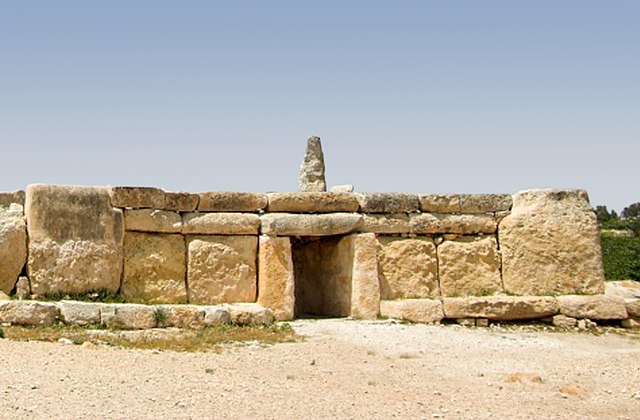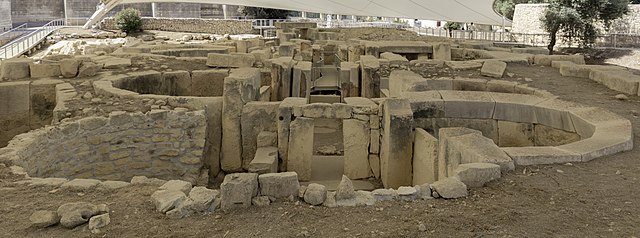VALLETTA, Malta – Descending three stories beneath the surface of the earth, the Hal Saflieni Hypogeum is nearly untainted by time. Made up of many chambers, the rooms are like miniature temples, mirroring the construction of the Tarxien Temples on the surface. The most powerful place, an unparalleled discovery, is on the third and final level: the Oracle Chamber. The room, decorated with red ochre spirals along the ceiling, is carved with such precision as to reverberate deep, resonant voices.
Built over 4,000 years ago, the structure was so well-constructed that despite millennia of earthquakes, 70,000 tons of bombs in the Second World War, and takeovers by numerous conquerors, there have been no cave-ins. Abandoned in 2500 BC and not rediscovered until 1902, the mystery of the Tarxien people and their way of life was nearly lost. But with modern science and consistent archaeology for the last hundred years, the marvel of their civilization is becoming known.

Malta [Photo Credit: Bengt Nyman CCA-SA 3.0]
The Tarxien people lived on Malta beginning around 3150 BC until 2500 BC when they mysteriously disappeared. The Tarxien Temples are one of the world’s oldest freestanding structures. The Hypogeum – Greek for “underground” – and other temples such as the one at Hagar Qim are some of the megalithic structures their civilization is now known for.
The Hypogeum was used as a burial chamber, and possibly a ritual site to communicate with or honor the ancestors. The burial practices are thought to have included allowing the bodies to decompose in an open space of the Hypogeum and then throwing the bones into a communal grave in one of the chambers. Visitors and priests would walk across the bodies as they formed a solid floor; the ancestors were literally the foundation of the Hypogeum. It is estimated that 7,000 bodies were buried there in all, though time and dampness decayed them beyond saving in many cases.
The unique acoustics of the space evince their intentional design, supporting theories that this was a space for ritual, not just burial. Heritage Malta, the Maltese organization that runs the museums and preserves the Tarxien sites with UNESCO, explained that the Tarxiens “understood the living rock”. When they carved the Hypogeum, they followed natural veins in the rock, finding them with small picks or possibly antlers driven into the stone as they delved. Tools used to excavate are suggested to be stone hammers.

The Façade Hagar Qim [Photo Credit: Hamelin de Guettelet CCA-SA 3.0]
The Tarxien people were a preliterate society, and carbon dating shows that their way of life – the carving styles, the burial proceedings, the statuary, and temple usage – ceased suddenly around 2500 BC, with no discernible explanation. But archaeology has uncovered undeniable evidence of feminine appreciation, possible matriarchy, and likely goddess worship. Statues of obese women, some as tall as nine feet, have been found at the temple sites. Because the site was left beneath the ground for so many millennia, it was never pillaged or destroyed by war, conquest, thievery, or religious persecution like the nearby ancient sites of Greece or Egypt. Only time has affected these temples, making them unique amongst other civilizations of their era.
The common theory regarding the Tarxien Temples is that they were dedicated to a fertility goddess. The statues found all have large hips and wide bosoms, and are either missing heads or seem to have interchangeable heads. These statues, known as “fat ladies,” are thought to represent the goddess. Like in Crete, a matriarchal nation Malta is known to have traded with during this time, the goddesses are depicted holding snakes, which were symbols of regeneration and fertility.
Smaller female figurines were found with the same exaggerated features, although these mostly had their heads intact. The Hypogeum had a deep well where the most famous of these figurines was found, the Sleeping Lady. It is theorized that these were votive offerings left at the well in a similar practice to the Greek sacred springs, or Celtic holy wells. It is very likely that the Tarxiens were ancestors of the Indo-Europeans, explaining these syncretic spiritual practices.

Tarxien Temples in Malta [Photo Credit: Diego Delso CCA-SA 4.0]
Spirals are a pervasive theme at each of the sacred sites in Malta. They are found on the ceiling of the Oracle Chamber in the Hypogeum, as well as on the altars and walls of temples, possibly as backsplashes for the large goddess statues. The spirals interlock in concentric circles as well, reminiscent of the carvings at Newgrange which date to around the same period. The meanings of these spirals can’t be known for sure, but it is theorized that, like other Indo-European cultures, they symbolize the cycle of life and death, the journey of the soul, or simply astrological observances, such as the sun or the Milky Way.
The paintings of spirals found in the Hypogeum used red ochre, which some scholars and archaeologists see as evidence of international trade, and therefore a potential for the exchange of ideas. Red ochre was an export from North Africa, including Egypt, as well as Sicily. Sicily at this time had a rich culture with similarities to the Tarxiens, called the Sicanians, indicating a cultural exchange. They lasted a similar amount of time, until the arrival of the Phoenicians in 900 BC; the Phoenicians had a large impact on Malta during that period, as well.
The Tarxien civilization doesn’t get the same attention as their Mediterranean neighbors in Egypt or Greece, yet they’ve left a lasting legacy that continues to intrigue both visitors and academics. Modern Pagans can continue to find a connection to this mysterious civilization through the commonalities of reverence for the Goddess and a veneration of the ancestors; which the Tarxiens have now become.
The Wild Hunt is not responsible for links to external content.
To join a conversation on this post:
Visit our The Wild Hunt subreddit! Point your favorite browser to https://www.reddit.com/r/The_Wild_Hunt_News/, then click “JOIN”. Make sure to click the bell, too, to be notified of new articles posted to our subreddit.
